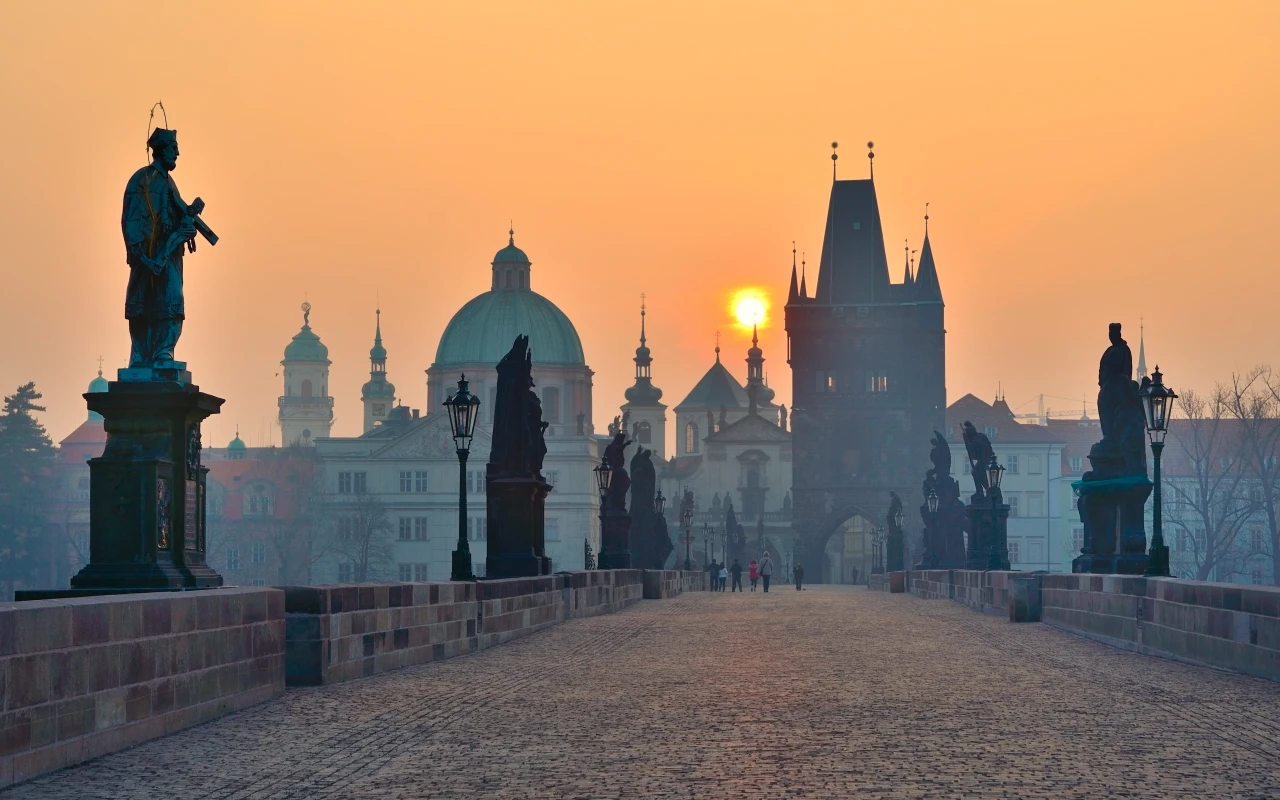Claim to Fame
Charles Bridge is Prague’s most famous medieval structure, featuring 16 arches and 30 Baroque statues, connecting Old Town and Prague Castle across the Vltava River since 1357.
📌 Navigating Charles Bridge : Answers to Frequently Asked Questions
- Washrooms: Public restrooms are not available on the bridge but can be found in nearby areas.
- Hours of Operation: The bridge is open at all times, but it can be very crowded during the day, especially in tourist season.
- Important Information: Early morning or late evening visits offer a quieter experience with beautiful lighting for photography.
- Admission Fee: No admission fee to walk across the bridge.
- How Long to Visit: Time spent on the bridge varies; visitors often take 30 minutes to an hour to enjoy the views and atmosphere.
- Parking: No parking available directly at the bridge; nearby public parking or public transport is recommended.
- Family Friendly: A great attraction for families, offering scenic views and access to street performers and vendors.
- Photography: Photography is a popular activity on the bridge, with many iconic views and statues.
- WIFI: No public WIFI available directly on the bridge.
- Picnic Area: No picnic areas on the bridge, but nearby Kampa Park offers space for outdoor meals.
- Handicap Accessible: The bridge is accessible to pedestrians and offers flat surfaces for easy walking.
- Pets: Pets can be taken on the bridge but should be kept on a leash due to the crowds.
- Guided Tours: No guided tours specific to the bridge, but it is often included in city walking tours.
- Restaurant or Cafe: No dining facilities on the bridge, but street vendors sell snacks and there are numerous restaurants nearby.
- Gift Shop: Souvenir vendors are common on the bridge, selling a variety of local crafts and goods.
Photos of Charles Bridge
Stretching 621 meters across the Vltava, Charles Bridge is a living monument of Gothic engineering and Baroque artistry. Constructed under King Charles IV in the 14th century, its stone arches and fortified towers frame one of Europe’s most romantic pedestrian thoroughfares. By day, the bridge pulses with street musicians, painters, and vendors; by night, its lantern-lit silhouette offers a quieter, almost mystical passage between Prague’s historic districts.
What to Expect
As you step onto the bridge from the Old Town side, you enter a bustling open-air gallery. Musicians play classical melodies near the Old Town Bridge Tower, while artists sketch the spires of St. Vitus Cathedral in the distance. Vendors sell handcrafted souvenirs and local snacks like trdelník (sweet spit cake).
Halfway across, the statue of St. John of Nepomuk—Prague’s patron saint—beckons visitors to touch its brass relief for good luck. Beyond, the Lesser Town Bridge Tower marks the gateway to the cobbled streets of Malá Strana and the ascent to Prague Castle.
Background and Cultural Context
Commissioned in 1357, Charles Bridge replaced the aging Judith Bridge and was completed in the early 15th century. Its 30 statues, added between 1683 and 1714, reflect the Counter-Reformation’s artistic flourish, depicting saints and patron figures in Baroque style.
The bridge has endured floods, wars, and countless processions—serving both strategic and ceremonial roles. Today it embodies Prague’s layered history, where Gothic foundations support Baroque ornamentation, and medieval stones bear the footprints of millions of visitors each year.
Best Time to Visit
Early morning, just after sunrise (around 5:00–6:30 AM), offers the most tranquil experience and soft golden light for photography. Late evening after sunset (around 9:30–10:30 PM) is also quieter, with the statues and towers illuminated against the night sky. Avoid midday on weekends to escape the heaviest crowds.
How to Get There
From Old Town Square, it’s a two-minute walk west along Karlova Street to the bridge’s eastern entrance at the Old Town Bridge Tower. From Malá Strana, descend from Malostranské náměstí toward the Lesser Town Bridge Tower. Nearby tram stops include Staroměstská (Line 17) and Malostranská (Lines 12, 22).
Photo Opportunities
- Silhouetted towers at dawn with mist rising off the Vltava
- Close-up of the St. John of Nepomuk statue’s relief and enchantment mark
- View from the riverbank capturing the full span and Prague Castle backdrop
- Nighttime reflections of lanterns and statues in the water
- Candid shots of musicians and painters at work along the balustrade
Travel Tips
- Arrive before 7 AM or after 9 PM to avoid crowds and pickpockets.
- Wear comfortable shoes—cobblestones are uneven and can be slippery when wet.
- Carry small local currency for tram fare and street vendors.
- Respect the statues—avoid leaning or climbing on them to protect their historic integrity.
- Combine your walk with a boat tour on the Vltava for a contrasting perspective.
FAQs
Is the Charles Bridge free to cross?
Yes—pedestrian access is free, and no tickets are required.
Can I cycle or drive on Charles Bridge?
No—the bridge is pedestrian-only. Cyclists must dismount and walk their bikes across.
Are there guided tours available?
Yes—many walking tours include Charles Bridge as a highlight, offering insights into its history and legends.
Is Charles Bridge accessible for strollers or wheelchairs?
The cobblestones and slight inclines can be challenging; assistance or alternative south-bank promenades are recommended.
Final Thoughts
Charles Bridge is more than a crossing—it’s Prague’s pulse, where centuries of art, legend, and urban life converge on stone. Whether bathed in dawn’s glow or sparkling under moonlight, this medieval masterpiece remains an unforgettable centerpiece of any Prague visit.
